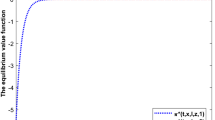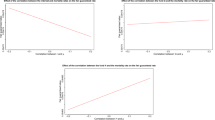Abstract
We consider a savings plan, where the paid capital is guaranteed at time of retirement, in the German market available as Riester-Rente and supported by federal cash payments and tax benefits. We generalize several capital guarantee mechanisms to payment plans and compare their distribution: the return distribution of a classical insurance strategy with investments in the actuarial reserve fund, a CPPI strategy, and a Stop loss strategy, in optimistic, standard and pessimistic market scenarios. To model the distribution we use a jump diffusion process parameterized to resemble the MSCI World index for the stock investment and a Hull-White Extended Vasicek process, calibrated to the euro zero-bond curve, for the risk free investment. We also analyze how fee structures and gap risk affect the performance of these savings plans. Additionally, we present a very simple parameter estimation method for this kind of simulation studies.





Similar content being viewed by others
Notes
MSCI Daily TR (Total Return) Gross (gross dividends reinvested) in USD.
Note that in the following it is not assumed that the insurance company knows about all payments at the beginning.
This applies to life insurance contracts in Germany until the end of 2011. For contracts signed after December 2011 the guaranteed interest is 1.75%.
The age of the insured is actually not important but it determines the lifetime of the contract as the time to retirement.
The possibility of negative rates is often seen as a drawback of Gaussian models and sometimes numerical adjustments are used to avoid them. We decided for two reasons to allow them. Firstly, negative rates could be observed in the past over short time periods. Secondly, a correction would not be in line with the pricing of zero coupon bonds under the risk neutral measure.
Hence we assume a deterministic instantaneous spot rate r t coinciding with the corresponding forward rate f 0,t observed at time 0.
References
Bacinello AR (2001) Fair pricing of life insurance participating policies with a minimum interest rate guaranteed. ASTIN Bull 31(2):275–297
Balder S, Brandl M, Mahayni A (2009) Effectiveness of CPPI strategies under discrete-time trading. J Econ Dyn Control 33(1):204–220
Balder S, Mahayni AB (2010) Cash-lock comparison of portfolio insurance strategies. Working paper, MSM, Duisburg University
Bertrand P, Prigent JL (2003) Portfolio insurance strategies: a comparison of standard methods when the volatility of the stock is stochastic. Int J Business 8(4):15–31
Bertrand P, Prigent JL (2005) Portfolio insurance strategies: OBPI versus CPPI. Finance 26:5–32
Black F, Perold A (1992) Theory of constant proportion portfolio insurance. J Econ Dyn Control 16(3-4):403–426
Black F, Scholes M (1973) The pricing of options and corporate liabilities. J Political Econ 81(3):637–654
Brigo D, Mercurio F (2001) Interest rate models-theory and practice. Springer, Berlin
Briys E, de Varenne F (1997) On the risk of insurance liabilities: debunking some common pitfalls. J Risk Insur 64:673–694
Cesari R, Cremonini D (2003) Benchmarking, portfolio insurance and technical analysis: a Monte Carlo comparison of dynamic strategies of asset allocation. J Econ Dyn Control 27(6):987–1011
Cont R, Tankov P (2009) Constant Proportion Portfolio Insurance in presence of jumps in asset prices. Math Finance 19:379–401
Detering N, Weber A, Wystup U (2011) Return distributions of equity-linked retirement plans, vol 2, 2nd edn. Statistical tools for finance and insurance. Springer, Berlin, pp 393–413
Gerstner T, Griebel M, Holtz M (2009) Efficient deterministic numerical simulation of stochastic asset-liability management models in life insurance. Insurance Math Econ 44(3):434–446
Hardy M (2003) Investment guarantees: modelling and risk management for equity-linked life insurance. Wiley Finance, London
Kou SG (2002) A jump-diffusion model for option pricing. Manage Sci 48(8):1086–1101
Kou SG, Wang H (2004) Option pricing under a double exponential jump diffusion model. Manage Sci 50(9):1178–1192
Acknowledgments
The authors would like to thank an anonymous reviewer whose suggestions improved the original version of the paper. Research support from MathFinance AG, Germany, is gratefully acknowledged.
Author information
Authors and Affiliations
Corresponding author
Appendices
Appendix 1
In the following we derive several properties of the displaced double exponential jump diffusion model and the parameter estimation.
1.1 Jump distribution
The jump part of the process has the density
with η1 > 1, η2 > 0 and 0 ≤ p ≤ 1. We show a graph of the density function in Fig. 6.
Similar to the work of Kou [15] we calculate
and
Using the relation \( \begin{aligned} Var[Y] = {\mathbb {E}} (Y^{2}) - {\mathbb {E}} (Y)^{2}\\ \end{aligned} \) we get
The drift due to the jump part is given by
1.2 Variance and volatility of log returns
The variance of the random number \(\ln\frac{S_t}{S_0}\) of the process (1) can be written as
and the volatility as
1.3 Parameter estimation
Here we describe the parameter estimation for the displaced double exponential jump diffusion process. We estimate the parameters based on the historical data of the MSCI Daily TR (Total Return) Gross (gross dividends reinvested) in USD for the period between January 1 1980 and October 2 2009. We denote these prices with \(x_0,x_1,\ldots ,x_N\) and the log-returns by
The estimate for the expected daily log return is
The estimate for the total volatility \(\hat{\sigma_1}_{tot}\) is
where N a is the number of observations per year.
To determine the parameters for the jump process we have to define a level κ such that d i with ||d i || ≥ κ is considered to be a jump. To determine this κ we calculate for a given level \(u\in[0,1]\) the u-quantile a and the (1 − u)-quantile b of the empirical distribution. For the analyzed MSCI World Index it turns out that a and b are almost symmetric and κ is taken such that κ ≃ b and −κ ≃ a. The level u should be chosen such that the resulting returns are intuitively considered as jumps. If u is chosen too high, even small log-returns are considered jumps, and if u is too low, almost no jumps occur. Of course, this level is subjective. We have chosen u = 0.01. In this case the minimal jump size is estimated κ = (b − a)/2 = 2.31% such that only daily changes of more than 2.31 % are considered to be jumps. Smaller changes can be explained with the diffusion part with sufficiently high probability. It also turns out that for the analyzed MSCI World Index, the average up-jump and the average down-jump is almost equal and we use η = η 1 = η 2 and p = 0.5.
The value η of the single parameter exponential distribution is chosen such that the mean of the distribution fits the mean of the observed jumps. From the financial data and the already fixed parameters we obtain h = 1/η = 1.121%. The number of jumps divided by the total number of observations yields an estimate for the jump frequency. Annualizing this frequency we can estimate λ to be 5.21, which intuitively is 2% of the trade days per year.
Finally we have to correct the estimator for the volatility according to (6) since the volatility consists of the jump part and the diffusion part. We define the constant drift parameter γ in (1) by γ: = μ − δ with δ as defined in (5) such that the process S t has the desired total drift μ, meaning
We summarize the estimated parameters in Table 10.
Appendix 2
Here we derive the distributional properties of the simple CPPI without borrowing restrictions under the following modelFootnote 6:
The value of the floor is F t = D t,T B. We follow mainly [2] with the difference that the instantaneous interest rate is allowed to change deterministically over time. Let C t : = P t − F t be the cushion process. Then
which is solved by
since \(S_t=S_0 \exp \left(\mu t - \frac{1}{2} \sigma^2 t + \sigma W_t \right). \) Together with C 0 = P 0 − B D 0,T and F t = B D t,T we obtain
which is the same as (4) since \(\int_0^t f_{0,s} {\rm d}s =- \ln D_{0,t}. \)
To derive \( {\mathbb {E}} \left[P_t \right], \) we recall that \( {\mathbb {E}} \left[ X\right]=\exp \left[\mu_X + 1/2 \sigma_X^2 \right], \) if \(\ln{X}\) is normally distributed with mean μ X and variance σ 2 X . Using Eq. (8) we get
This shows that in the uncapped CPPI the expected value of the total investment can be increased by increasing the multiplier m as long as the integrated forward rate is smaller than the integrated equity fund drift.
Appendix 3
In order to test robustness we also estimate the parameters for the double exponential jump diffusion model without displaced jumps and compare the simulation results. We follow [11] by estimating the parameters based on the empirical characteristic function of the logarithmic returns. Let \(\hat{\Uppsi}(u)\) be the empirical characteristic function and \(\Uppsi_{\theta}(u)\) the theoretical characteristic function for the model with parameter set θ. The estimation then reduces to minimizing the quadratic distance
where w(u) is a weighing function and K the cutoff parameter. We use the weighing function:
with σ 2 D being the variance of the log returns \(d_1,\ldots,d_N. \) The minimization is done with a simulated annealing algorithm. We summarize the estimated parameters in Table 11. The minimization converges very slowly and different value for the temperature of the annealing algorithm and different starting values lead to rather different estimations for h and λ. This is due to the fact that there are several combinations of the two parameters which lead to almost the same fit to the data. It is hard to distinguish whether there are small jumps with high intensity or larger jumps with low intensity. The parameter p and \(\hat{\sigma}_1\) turn out to be much more stable. While p is very close to 0.5 as we found also with our method, the volatility \(\hat{\sigma}_1\) is estimated greater without the displaced jumps. This is reasonable since there is a positive probability that also the diffusion part of the process causes movements above the minimum jump size κ when discretized. These movements are neglected in our estimation method for the diffusion part since they are all attributed to the jumps. We show the simulation results in Table 12. We find that the results for the mean, the median and the exposure are very similar. Both model describe the return distribution very well. For the normal double exponential jump diffusion model the gap risk is also zero for the capped CPPI. For Stop loss, the average realized gap is smaller than with the displaced jumps due to the lower expected jump size but in turn the higher intensity.
Rights and permissions
About this article
Cite this article
Detering, N., Weber, A. & Wystup, U. Return distributions of equity-linked retirement plans under jump and interest rate risk. Eur. Actuar. J. 3, 203–228 (2013). https://doi.org/10.1007/s13385-013-0061-0
Received:
Revised:
Accepted:
Published:
Issue Date:
DOI: https://doi.org/10.1007/s13385-013-0061-0





